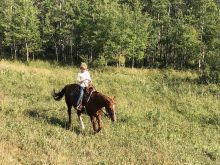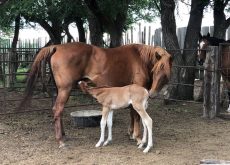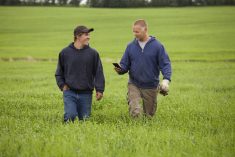February is Heart Month and a good time to work on the state of your union: marriage, spousal relationships and couple care. John Gottman is a highly respected U.S. psychologist and author of The Seven Principles for Making Marriage Work. Here I’ve added a farm perspective to his tips based on those seven principles.
Sharing love maps
“When you choose to spend your life with someone, you hand them a map to your inner world. Your inner world is, of course, quite complex including the memories of your past, the details of your present, your hopes for the future. It includes your deepest fears and your grandest dreams,” Gottman writes.
Read Also

Gentle treatments for pain in the neck
Heading toward year-end, people unknowingly tense up against the cold and busyness, causing neck pain that can often be treated with appropriate support and gentle mobility, athletic therapist Kathlyn Hossack says.
As you talk about aging in place on your farm, are you sharing your inner world with your spouse? What does a good day on the farm look like to you as you age and your health shifts? I like to ask my farmer husband what he is looking forward to in the next year. Three or four times a week I will check in and ask if he’s OK and how he’s feeling.
Nurturing fondness and admiration
Dr. Gary Chapman is the author of The Five Love Languages. I think this book should be required reading for all couples. You can grab it on Audible.
My love language is words of affirmation and meaningful touch. My husband doesn’t want a card: he wants action, acts of service like hot meals or cleaning his pickup truck. This caused some tension for readers when I wrote an earlier blog post titled “How to love your farmer.” Farmers are male and female. We can have stronger marriages and relationships when we choose to care for each other. Unfortunately, some couples feel like one side of the couple is doing most of the heavy lifting. Talk about this and resolve to change your attitudes and actions.
Turning toward each other, instead of away
Recently on a beach holiday I used a harsh tone of voice for my displeasure in not being able to find which direction my husband had gone. He apologized for assuming I knew where he was, and then he walked away from me talking. This demonstrated his need for me to be facing him closely, turned toward him when we are communicating. Old habits may not be helpful to better communication. Turn toward each other, make eye contact and patiently listen attentively without formulating your answer too quickly. Are you turned toward your spouse? Can you let the light in your eyes communicate love and appreciation?
Letting your partner influence you
How open are you to feedback from your spouse? Lesley Kelly and her husband Matt use a great tool of numbering how they are feeling from a scale of one to 10. ‘10’ is great and a ‘2’ means not good. This helps them communicate clearly about the next steps to support and influence each other’s mental wellness. Read more on Lesley’s web site.
This numbering system is also outlined in Michael Pantalon’s book Instant Influence, when you need to peg down the exact distance between your perspective and someone else’s.
I had the honour of hearing Lesley speak in November at the StrongHer Together Conference at Fort Benton, Montana. Lesley has many practical tools for navigating farm life and the mantra her dad gave her is “You are stronger than you think.”
Solving your solvable problems
Some problems or challenges are polarities: things that will never be totally solved but need to be managed. The dance between work on the farm and the need for family time or play will never be totally solved, but it needs to be addressed with creative solutions that give families time to grow, as well as attention to farm work.
Creating solutions is a positive conflict behaviour. Instead of ranting on social media about how terrible your life is on the farm with workaholics, what solutions are you both willing to create? How can you employ a set of “fresh eyes” to see options for a different way of being and doing things? Is it time to hire a coach or facilitator to help you employ new actions?
Overcoming gridlock
Gottman has also used the term “make quick repair.” I like this approach. When there is conflict, are you walking away with avoidance, or are you leaning in to offer your perspective, create solutions and express your emotions in a respectful way to resolve the gridlock? Our team can provide an online assessment for $55 per person with the conflict dynamic profile, to help you be more self-aware of your positive and destructive conflict behaviours. It also helps you understand what your hot buttons are. My hot buttons are folks who are aloof and will not talk with me, and those people who don’t show up on time or meet deadlines; they are unreliable.
Creating shared meaning together
Gottman suggests rituals of connection (like how we start and end our day), roles, life goals and values.
When our goals and values are aligned as a couple, we are like a well-matched team of work horses pulling in the same direction. I am curious: when was the last time you sat down, as a couple, to talk about what currently gives your life purpose and meaning? Seeing the long game ahead with joyful anticipation is a healing story, but dread for the future is stressful. Proverbs 13:12 says, “Hope deferred makes the heart sick, but a longing fulfilled is like a tree of life.”
Do you have good things to anticipate this year as a couple? Connection with family, friends, neighbours? Celebrations? Community involvement? Are there things to navigate differently as your roles on the farm are changing? Are your money scripts and financial roles aligned?
If you are ready to process two other great books to enhance your marriage, pick up Love and Respect by Dr. Emerson Eggerichs and Nonviolent Communication by Dr. Marshall Rosenberg.
Farm marriages navigate the seasonal changes of a farming year — and they also need to be adaptable to the changing needs and role expectations of each spouse. Ask our coaching team to help you find harmony through understanding with coaching facilitation.
















